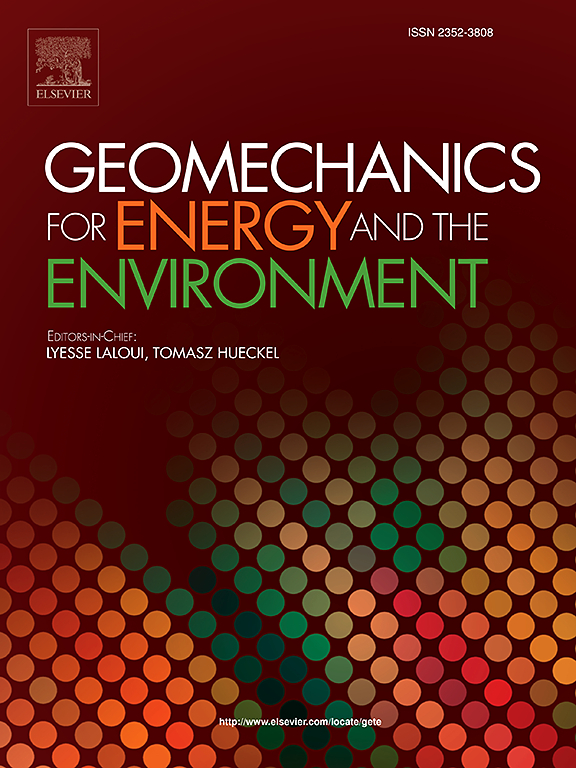Development of experimental system for rock anisotropic seepage under true triaxial stress
IF 3.3
2区 工程技术
Q3 ENERGY & FUELS
引用次数: 0
Abstract
In order to study the mechanical properties and anisotropic seepage behavior of rocks under complex stress conditions in deep strata, an anisotropic seepage dynamic monitoring system for true triaxial stress conditions was developed. In the process of research and development, four key technologies have been successfully broken through: (1) the use of an independently designed sealing system ensures complete sealing during seepage experiments, reduces experimental errors, and eliminates the edge effect through the six-axis linkage technology; (2) the specially designed multifunctional platen is capable of hydraulic fracturing, seepage, and data acquisition in the true triaxial experiments; (3) Integrated acoustic emission and seepage monitoring system, which can realize real-time dynamic monitoring of crack extension and seepage evolution under real triaxial stress conditions; (4) The control system supports real triaxial stress loading of up to 280 MPa, and it has a stress response sensitivity of 0.5 kPa/s, which ensures high-precision loading and monitoring. The crack extension modes of rocks under true triaxial stress conditions were systematically studied to reveal the dynamic relationship between crack extension and seepage paths. The results show that cracks preferentially extend in the direction of maximum principal stress, leading to a significant increase in seepage rate, while seepage rate lags in the direction of minimum principal stress due to the crack closure effect. A nonlinear "rise-decline-rise" dynamic relationship was observed between crack extension and seepage rate. This study provides new insights into the coupling mechanism between crack extension and seepage behavior under complex stress conditions.
真三轴应力下岩石各向异性渗流试验系统的建立
为了研究深部复杂应力条件下岩石的力学特性和各向异性渗流行为,研制了真三轴应力条件下岩石各向异性渗流动态监测系统。在研发过程中,成功突破了四项关键技术:(1)采用自主设计的密封系统,保证了渗流实验时的完全密封,减少了实验误差,并通过六轴联动技术消除了边缘效应;(2)专门设计的多功能平台,具有水力压裂、渗流和真三轴实验数据采集功能;(3)声发射与渗流一体化监测系统,可实现真实三轴应力条件下裂缝扩展与渗流演化的实时动态监测;(4)控制系统支持高达280 MPa的真实三轴应力加载,应力响应灵敏度为0.5 kPa/s,保证了高精度加载和监测。系统研究了真三轴应力条件下岩石的裂纹扩展模式,揭示了裂纹扩展与渗流路径的动态关系。结果表明:裂缝优先向最大主应力方向扩展,导致渗流速率显著增加,而由于裂缝闭合效应,渗流速率在最小主应力方向滞后;裂缝扩展与渗流速率呈非线性“升-降-升”动态关系。该研究为复杂应力条件下裂缝扩展与渗流行为的耦合机理提供了新的认识。
本文章由计算机程序翻译,如有差异,请以英文原文为准。
求助全文
约1分钟内获得全文
求助全文
来源期刊

Geomechanics for Energy and the Environment
Earth and Planetary Sciences-Geotechnical Engineering and Engineering Geology
CiteScore
5.90
自引率
11.80%
发文量
87
期刊介绍:
The aim of the Journal is to publish research results of the highest quality and of lasting importance on the subject of geomechanics, with the focus on applications to geological energy production and storage, and the interaction of soils and rocks with the natural and engineered environment. Special attention is given to concepts and developments of new energy geotechnologies that comprise intrinsic mechanisms protecting the environment against a potential engineering induced damage, hence warranting sustainable usage of energy resources.
The scope of the journal is broad, including fundamental concepts in geomechanics and mechanics of porous media, the experiments and analysis of novel phenomena and applications. Of special interest are issues resulting from coupling of particular physics, chemistry and biology of external forcings, as well as of pore fluid/gas and minerals to the solid mechanics of the medium skeleton and pore fluid mechanics. The multi-scale and inter-scale interactions between the phenomena and the behavior representations are also of particular interest. Contributions to general theoretical approach to these issues, but of potential reference to geomechanics in its context of energy and the environment are also most welcome.
 求助内容:
求助内容: 应助结果提醒方式:
应助结果提醒方式:


